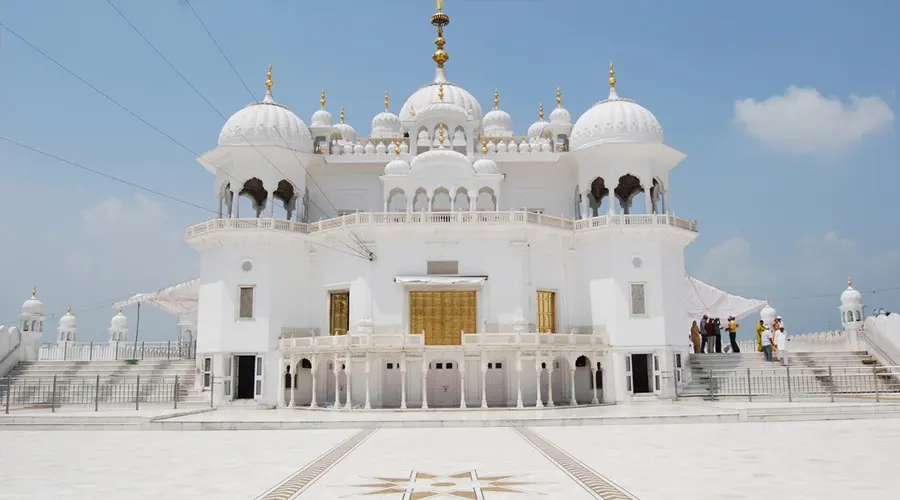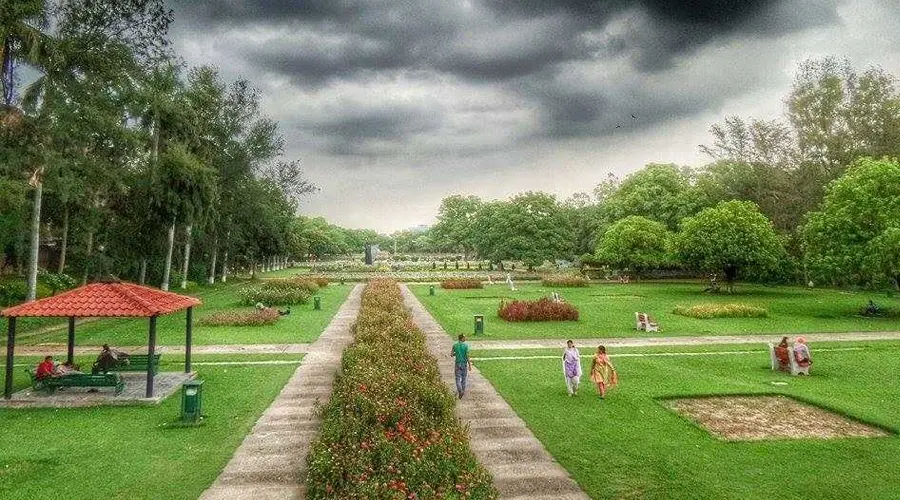Capitol Complex
In the heart of this bustling city stands a symphony of concrete, steel, and dreams – the Capitol Complex. Designed by the legendary architect Le Corbusier, this architectural marvel is more than just a collection of buildings; it's a testament to the boundless possibilities of human ingenuity.
Walking through the Capitol Complex is like navigating through a narrative of architectural innovation. Each structure, meticulously placed in relation to the others, tells a story of function, aesthetics, and the pursuit of an ideal society. The interconnectedness of the buildings mirrors the interdependence of the diverse facets of governance and life itself.
Beyond the concrete and steel, the Capitol Complex serves as a canvas for artistic expression. Every beam, every angle, and every shadow seems to be carefully orchestrated by the sun, casting a play of light and shadow that evolves throughout the day. The changing hues and patterns create a living, breathing masterpiece that beckons photographers, artists, and dreamers alike.
And so, as you wander through the Capitol Complex in Chandigarh, you become a part of its legacy. You're not merely a spectator; you're an explorer, a thinker, and a dreamer. You're stepping into the footsteps of Le Corbusier's visionaries, witnessing the convergence of art and architecture, and experiencing a microcosm of a city's essence. In the Capitol Complex, Chandigarh doesn't just have buildings – it has a soul, a story, and an indomitable spirit that continues to inspire all who pass through its hallowed grounds.
Design and Architecture of Capitol Complex
The Capitol Complex stands as a remarkable example of modernist architecture and urban planning. Designed by renowned architect Le Corbusier, in collaboration with his cousin Pierre Jeanneret and a team of talented architects, the complex embodies the principles of functionalism, rationalism, and a forward-looking vision of urban development.
It is a significant part of Chandigarh's identity and a UNESCO World Heritage Site since 2016.
Design Philosophy:
The design philosophy behind the Capitol Complex was deeply rooted in Le Corbusier's modernist ideals. It sought to create a utopian urban environment that harmoniously combined nature, art, and architecture while accommodating the needs of a growing administrative center. The design prioritized functionality, simplicity, and the use of new materials and construction techniques.
Components of the Capitol Complex:
The Capitol Complex is composed of several key components, each with its unique architectural significance:
- The Legislative Assembly: This is the central and most iconic building of the complex. Its distinctive shape resembles an open hand, symbolizing peace and unity. The building is elevated on pilotis (columns) and features large brise-soleil (sun-breaking) panels that not only provide shade but also create a unique play of light and shadow. The interior spaces are designed to facilitate efficient legislative proceedings.
- The Secretariat: Flanking the Legislative Assembly, the Secretariat houses the administrative offices of the government. It consists of several interconnected blocks raised on pilotis, ensuring a visually light and open appearance. The design emphasizes functionality, with wide corridors and efficient layouts to accommodate administrative functions.
- The High Court: Situated at the other end of the complex, the High Court building features a design reminiscent of ancient Indian architecture. It combines modernist principles with traditional elements, like the use of exposed brick and the integration of water bodies. The design reflects Le Corbusier's desire to create a dialogue between modernity and local culture.
- Open Spaces and Landscaping: The Capitol Complex is surrounded by expansive open spaces and meticulously landscaped gardens. The plaza between the Legislative Assembly and the Secretariat, known as the Plaza of Open Hand, serves as a central gathering space. Water bodies, sculptures, and greenery enhance the aesthetic and functional aspects of the complex, aligning with Le Corbusier's belief in the harmony between nature and architecture.
Innovations and Significance of Capitol Complex:
The Capitol Complex is noteworthy for its innovative design and architectural features:
- Brutalist Aesthetic: The extensive use of concrete, exposed brick, and geometric forms characterizes the complex's brutalist aesthetic, which was quite unconventional for its time. This approach showcases the raw materials and construction techniques while embodying the functionalist ideals of the modernist movement.
- Modular Grid System: Le Corbusier employed a modular grid system for the complex's design, enabling a coherent and systematic arrangement of elements. This modular approach facilitated flexibility and adaptability while maintaining visual harmony.
- Human-Centric Planning: Despite its monumental scale, the complex was designed with human-scale considerations. The interconnected pathways, green spaces, and thoughtful integration of art and architecture create an environment that encourages people to interact and engage.
- Cultural Integration: Le Corbusier's incorporation of local elements, such as the use of Indian materials, craftsmanship, and symbolic motifs, reflects his respect for the cultural context and desire to establish a connection between tradition and modernity.
The Capitol Complex in Chandigarh remains a testament to the innovative spirit of modernist architecture and the vision of Le Corbusier. Its design principles have left an enduring impact on architectural discourse and continue to inspire architects and urban planners worldwide.
Things to do at Capitol Complex
- Architectural Marvel Exploration: Immerse yourself in the genius of Le Corbusier's architecture. Take a guided tour or explore on your own, marveling at the geometric precision and innovative design of the High Court, Legislative Assembly, and the Open Hand Monument. Capture the intricate details of these structures and discover the underlying philosophy behind their creation.
- Historical Insights: Engage in a guided tour that delves into the history and significance of the Capitol Complex. Knowledgeable guides can provide insights into the vision of Le Corbusier, the political importance of these structures, and the journey of Chandigarh as a planned city.
- Architectural Sketching: If you're artistically inclined, bring along your sketchbook and capture the lines, shapes, and forms of the buildings. The unique geometric patterns and the interplay of light and shadow make for captivating subjects for artistic expression.
- Spectacular Sunsets: As the day draws to a close, witness the magic of a Chandigarh sunset from the Capitol Complex. The structures against the backdrop of the setting sun create a dramatic and picturesque scene that's bound to leave a lasting impression.
- Photo Walk: Whether you're a professional photographer or simply a smartphone enthusiast, the Capitol Complex offers a myriad of breathtaking angles, textures, and lighting conditions that are perfect for capturing stunning photographs. Experiment with different perspectives and lighting to create your own visual masterpiece.
- Picnic Amidst History: Pack a picnic basket and enjoy a leisurely meal on the vast lawns of the Capitol Complex. Spread out a blanket under the open sky, surrounded by iconic structures and lush greenery. It's a serene setting that combines relaxation with a touch of grandeur.
- Contemplative Retreat: Find a quiet spot, perhaps near the Open Hand Monument, and immerse yourself in meditation or deep contemplation. The harmonious blend of architecture and nature provides a soothing atmosphere conducive to reflection and introspection.
- Photography Workshops: Join a photography workshop or tour that specifically focuses on capturing the architectural beauty of the Capitol Complex. Learn from experts about composition, lighting, and techniques to enhance your photography skills.
- Educational Visits: Plan an educational visit with students to introduce them to the world of architecture, urban planning, and design. The Capitol Complex offers an inspiring environment for students to learn about these subjects in a practical and immersive way.
- Cultural Events: Check local event listings for any cultural events, exhibitions, or performances being held at the Capitol Complex. It's not uncommon for this space to host art exhibitions, cultural festivals, and other gatherings that showcase the artistic and creative side of Chandigarh.
Geometric Hill in Capitol Complex
Geometric Hill, located within the Chandigarh Capitol Complex in sector 1, is a fascinating UNESCO World Heritage Site. Designed by the renowned architect Le Corbusier, this hill covers an area of approximately 100 acres and stands as a remarkable manifestation of Chandigarh’s distinctive urban design and planning.
Here are some intriguing details about Geometric Hill:
Construction Waste Artistry: Le Corbusier ingeniously crafted this hill using construction waste. It serves a dual purpose: concealing the legislative assembly building from the nearby main road and showcasing artistic ingenuity.
Mound-Shaped Monument: The hill takes on a mound-like shape, emphasizing geometric precision and meticulous design principles.
UNESCO Recognition: In 2016, Geometric Hill was inscribed as part of the UNESCO World Heritage Site list, along with other works by Le Corbusier, recognizing its significant contribution to modernist architecture.


























